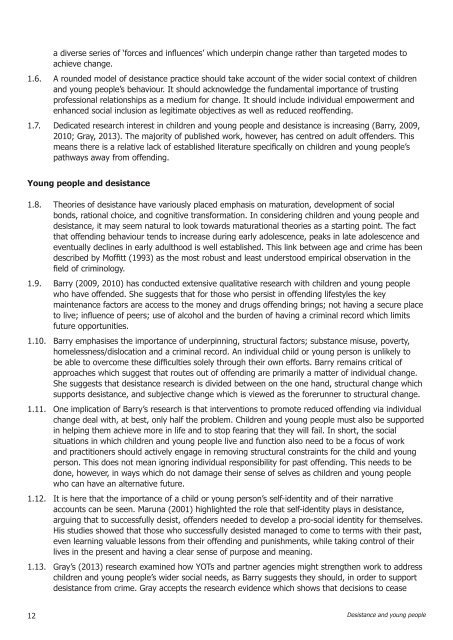Desistance and young people
Desistance_and_young_people
Desistance_and_young_people
Create successful ePaper yourself
Turn your PDF publications into a flip-book with our unique Google optimized e-Paper software.
a diverse series of ‘forces <strong>and</strong> influences’ which underpin change rather than targeted modes to<br />
achieve change.<br />
1.6. A rounded model of desistance practice should take account of the wider social context of children<br />
<strong>and</strong> <strong>young</strong> <strong>people</strong>’s behaviour. It should acknowledge the fundamental importance of trusting<br />
professional relationships as a medium for change. It should include individual empowerment <strong>and</strong><br />
enhanced social inclusion as legitimate objectives as well as reduced reoffending.<br />
1.7. Dedicated research interest in children <strong>and</strong> <strong>young</strong> <strong>people</strong> <strong>and</strong> desistance is increasing (Barry, 2009,<br />
2010; Gray, 2013). The majority of published work, however, has centred on adult offenders. This<br />
means there is a relative lack of established literature specifically on children <strong>and</strong> <strong>young</strong> <strong>people</strong>’s<br />
pathways away from offending.<br />
Young <strong>people</strong> <strong>and</strong> desistance<br />
1.8. Theories of desistance have variously placed emphasis on maturation, development of social<br />
bonds, rational choice, <strong>and</strong> cognitive transformation. In considering children <strong>and</strong> <strong>young</strong> <strong>people</strong> <strong>and</strong><br />
desistance, it may seem natural to look towards maturational theories as a starting point. The fact<br />
that offending behaviour tends to increase during early adolescence, peaks in late adolescence <strong>and</strong><br />
eventually declines in early adulthood is well established. This link between age <strong>and</strong> crime has been<br />
described by Moffitt (1993) as the most robust <strong>and</strong> least understood empirical observation in the<br />
field of criminology.<br />
1.9. Barry (2009, 2010) has conducted extensive qualitative research with children <strong>and</strong> <strong>young</strong> <strong>people</strong><br />
who have offended. She suggests that for those who persist in offending lifestyles the key<br />
maintenance factors are access to the money <strong>and</strong> drugs offending brings; not having a secure place<br />
to live; influence of peers; use of alcohol <strong>and</strong> the burden of having a criminal record which limits<br />
future opportunities.<br />
1.10. Barry emphasises the importance of underpinning, structural factors; substance misuse, poverty,<br />
homelessness/dislocation <strong>and</strong> a criminal record. An individual child or <strong>young</strong> person is unlikely to<br />
be able to overcome these difficulties solely through their own efforts. Barry remains critical of<br />
approaches which suggest that routes out of offending are primarily a matter of individual change.<br />
She suggests that desistance research is divided between on the one h<strong>and</strong>, structural change which<br />
supports desistance, <strong>and</strong> subjective change which is viewed as the forerunner to structural change.<br />
1.11. One implication of Barry’s research is that interventions to promote reduced offending via individual<br />
change deal with, at best, only half the problem. Children <strong>and</strong> <strong>young</strong> <strong>people</strong> must also be supported<br />
in helping them achieve more in life <strong>and</strong> to stop fearing that they will fail. In short, the social<br />
situations in which children <strong>and</strong> <strong>young</strong> <strong>people</strong> live <strong>and</strong> function also need to be a focus of work<br />
<strong>and</strong> practitioners should actively engage in removing structural constraints for the child <strong>and</strong> <strong>young</strong><br />
person. This does not mean ignoring individual responsibility for past offending. This needs to be<br />
done, however, in ways which do not damage their sense of selves as children <strong>and</strong> <strong>young</strong> <strong>people</strong><br />
who can have an alternative future.<br />
1.12. It is here that the importance of a child or <strong>young</strong> person’s self-identity <strong>and</strong> of their narrative<br />
accounts can be seen. Maruna (2001) highlighted the role that self-identity plays in desistance,<br />
arguing that to successfully desist, offenders needed to develop a pro-social identity for themselves.<br />
His studies showed that those who successfully desisted managed to come to terms with their past,<br />
even learning valuable lessons from their offending <strong>and</strong> punishments, while taking control of their<br />
lives in the present <strong>and</strong> having a clear sense of purpose <strong>and</strong> meaning.<br />
1.13. Gray’s (2013) research examined how YOTs <strong>and</strong> partner agencies might strengthen work to address<br />
children <strong>and</strong> <strong>young</strong> <strong>people</strong>’s wider social needs, as Barry suggests they should, in order to support<br />
desistance from crime. Gray accepts the research evidence which shows that decisions to cease<br />
12 <strong>Desistance</strong> <strong>and</strong> <strong>young</strong> <strong>people</strong>


